If Nadia Vulvokov and Theresa “Tree” Gelbman met in the women’s bathroom at a party, they would see little in common, standing side-by-side looking into the mirror: 36-year-old redheaded game designer next to 22-year-old blonde co-ed, the latter too good for this and the former too checked-out to care. But these women are linked by time, by death, and by one Phil Connors.
Over twenty-five years ago, Groundhog Day introduced one of the best-known interpretations of the time loop story, with a particular focus on self-improvement via existential crisis and some morbid humor. A quarter-century later, thanks to one-off TV episodes and a growing number of entire movies and TV series dedicated to the premise, the time loop is a veritable subgenre—and Phil’s near-infinite journey of self-discovery has provided the blueprint for new narratives to riff upon, to subvert, and, most importantly, to gender-swap.
This past February saw the release of two time loop stories with female leads: Happy Death Day 2U, the sequel to 2017’s snarky slasher flick Happy Death Day, starring Jessica Rothe; and Russian Doll, Leslye Headland, Natasha Lyonne, and Amy Poehler’s weird, wonderful limited series. While Tree and Nadia occupy vastly different stages of life, the violent time loops in which they are trapped are shockingly similar: both must relive difficult birthdays, dying over and over in order to find a way out, while grappling over guilt related to their dead mothers. Center a woman in a time loop story, and she becomes the Ginger Rogers to Phil’s Fred Astaire: “She did everything he did,” the quote goes, “backwards and in high heels.” Women in time loop stories are subject to gaslighting, forced to constantly justify themselves to others, and, most damningly, don’t get infinite chances to make it right.
Spoilers for Russian Doll and both Happy Death Day movies.
But first, it begins with a birthday. On September 18, Tree is jolted awake by the truly grating “Busy Day Birthday” ringtone: Yay it’s my birthday / And I ain’t gonna pick up the phone / Yay it’s my birthday / Y’all should just leave me alone. Worse is the fact that it’s her father calling; her mother died some years ago, but they shared a birthday, so every year when her dad gamely tries to keep it a cheerful celebration for her, she can’t help but push him away, and then mires in that self-loathing. On an indeterminate night, Nadia steels herself in the bathroom in order to rally for the party thrown in her honor, even though she would rather let the day pass without fanfare. She is 36, the age her troubled mother never made it to, and suffers the requisite guilt of her mere existence. The party song, Harry Nilsson’s “Gotta Get Up,” mirrors her internal monologue: Gotta get up, gotta get out, gotta get home before the morning comes / What if I’m late, gotta big date, gotta get home before the sun comes up / Up and away, got a big day, sorry can’t stay, I gotta run, run, yeah / Gotta get home, pick up the phone, I gotta let the people know I’m gonna be late.
By the end of the night, Nadia’s body will be sprawled on Avenue A, struck by a cab; Tree’s corpse, run through with a knife, will be found on campus, the quintessential horror-movie first-act murder. Each will die at least a dozen more times, in increasingly violent ways, before she solves the mystery behind her predicament.
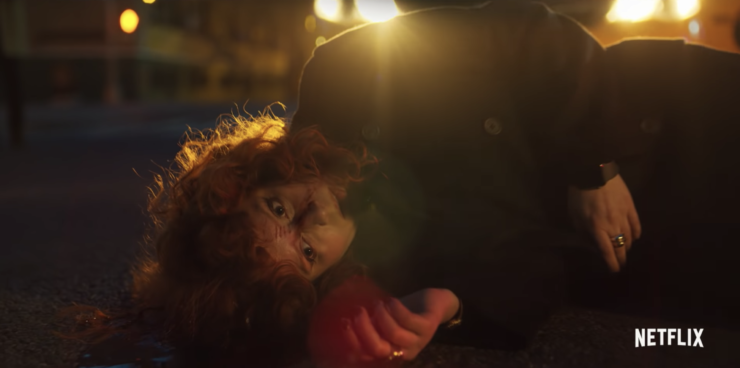
Phil’s prison is Groundhog Day itself: No matter if he goes to sleep at the end of a satisfying day or dies before sundown, he wakes up to “I Got You Babe” on the clock radio on the morning of February 2. Reliving the day is the mystery; dying is a side effect, a failed attempt at a solution. Several failed attempts, borne out of Phil’s growing depression once the loop shows no signs of resolving. As he explains to love interest Rita in one of the film’s most memorable sequences:
I’m a god. I’m not the God, I don’t think. […] I didn’t just survive a wreck, I wasn’t just blown up yesterday. I have been stabbed, shot, poisoned, frozen, hung, electrocuted, and burned. Every morning I wake up without a scratch on me, not a dent in the fender. I am an immortal.
The montage of suicides is just one of several stages through which Phil tries to escape his temporal quandary. Reliving the day is the point.
For Nadia and Tree, death—escalating deaths that make them the victims of a knife-wielding, baby-masked killer or Final Destination-esque freak accidents—is the point. Nadia is even able to wake up the next morning, start a whole new day and move through the world, at least to the next night… but the moment she falls into the East River or plummets to her death in a broken elevator, she’s back in the bathroom at her birthday party. While Tree is stuck in the one day, she experiences a similar process so encouraging—acquires the seemingly perfect missing clues to the puzzle—that watching her get cut down by Babyface yet again is almost as viscerally painful for the viewer as her anguished screams upon waking to “Busy Day Birthday” for the nth time.
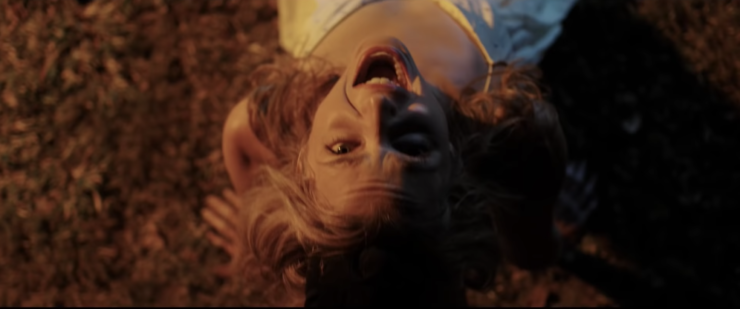
Phil wakes up alone (no matter who he went to bed with), but Tree is not so lucky; every time the loop resets, earnest underclassman Carter is there to greet her, after she passed out drunk in his bed the night before. While she’s trying to shimmy into her jeans and wedge on last night’s heels, he’s hovering unhelpfully—and then there’s his roommate Ryan, swooping in to find out if he “tapped that ass” yet. As Tree wakes over and over from brutal deaths worse than any nightmare—and from increasingly longer loops, some in which she has actually gotten to know Carter—she must endure the same awkward pleasantries with these boys as she rushes out the door for the latest attempt to solve her own murder. Even when she does confide in Carter and he provides emotional support (and even insights into the mystery), she is still devoting time, and breath, and emotional labor to catching him up on the situation. There’s a reason we only see Phil let Rita in on his situation the one time.
While at first Nadia has only her own reflection to confront, almost immediately there’s an impatient knock at the door. Because she has returned to somewhere almost worse than an undergrad’s dorm room: the only bathroom at a house party with a line of people waiting—and beyond them, dozens of partygoers she is obligated to greet, to entertain with an amusing anecdote, to share a shot or drag with. As she, like Tree, attempts to flee via stairs (bad idea) or fire escape in order to follow various leads around the neighborhood, she’s branded the ungrateful bitch who can’t be present with the people giving up their time for her—unable to realize that Nadia does not have time to stop.
Nadia and Tree’s respective time loops, in keeping with the subgenre, hold them captive until they accept the need to work out past traumas and force them to consider that they are part of the problem and might need to change how they interact with the world. But in addition, both stories force them to do that work in front of other people instead of being allowed to process the changes on their own—and often, they suffer the further indignity of not being believed. For Tree, it’s because she’s a seemingly dumb sorority girl trying to explain time loops to physics majors; Nadia is undercut by her mother’s history of breaking with reality. Justifying their impossible situations only further saps their energy to actually solve them.
Phil Connors is a misanthrope who gets to choose how much he isolates himself from the annoyingly cheerful and invasive inhabitants of Punxsutawney; as much as he complains about his daily interactions with these people, how much he ultimately learns about each of them is on his terms. Nadia and Tree, by contrast, are dogged by ex-boyfriends with daughters (or wives) demanding their time, surrogate or biological parents hovering uselessly instead of giving them space, roommates sassing them for late nights and friends throwing drinks on them for abandoning their own birthday parties. Confronting the loop alone is a privilege Phil receives, and one that Tree and Nadia are denied. Even their supposed allies, Tree’s love interest Carter and Nadia’s kindred spirit Alan (trapped in his own loop, but linked to her by their shared deaths), become witnesses to whom they are held accountable for their emotional progress, while they’re still stumbling their way through.
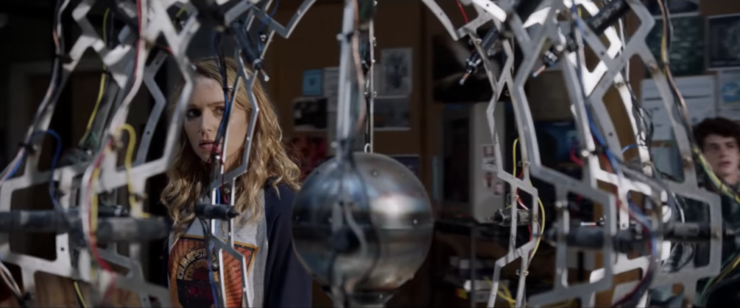
What’s worse, each woman can trace at least part of the reason for her predicament to these men. While the Groundhog Day script experimented with—and ultimately scrapped—an explanation for why Phil gets cursed into his time loop, neither Nadia nor Tree benefits from that same ambiguity. Happy Death Day director Christopher Landon said that he came up with the idea for the sequel while in post-production on the first film; sitting in the editing room, watching countless repetitions of Carter’s roommate Ryan’s entrance, Landon thought to himself, “Wouldn’t it be funny if he was the reason this happened?” Funny meaning that a character who started as a punchline gets an entire side plot in which he is a physics major trying to protect his thesis project, an experimental quantum reactor, from getting shut down since all it’s achieved so far is shutting down the university’s electricity… and, unbeknownst to anyone but Tree, creating her September 18 time loop. Funny meaning her entire emotional arc is reduced to a fluke side effect of a faulty science experiment.
And then in the sequel she gets thrown into a parallel universe in which she wakes up in a murder-y time loop again. Ha. Ha. Except this time, Tree doesn’t have any of the clues and plenty of distractions: her roommate Lori is no longer the killer, Carter is dating her repulsive sorority sister Danielle… and her mother is alive. Hilarious.
It’s not funny, not even in a morbid way, when Alan realizes that his first death seems to be the root for his and Nadia’s shared loops. It’s not until the sixth episode of Russian Doll that he remembers what caused his first death, the one that coincided with Nadia getting struck by the cab: he “threw [himself] off” his roof, and to match that deliberate action, the universe conjured the cab to hit Nadia at the exact same moment. It’s indicative of Nadia’s developing empathy at this point in the season that she is so terribly kind when receiving Alan’s tearful confession, but she also ensures that he understands the important distinction: his suicide is not the reason they are linked in the first place, only a catalyst for her first death.

In managing the external forces acting upon them—not just the rules of their respective loops, but also the expectations and obligations of loved ones and relative strangers—the women in time loop stories have the self-awareness to realize when they are the external force acting upon others. One of the things that’s long stayed with me from Leah Schnelbach’s excellent Groundhog Day essay (aside from dismantling so many genres!) was her point that in every reality in which Phil offs himself (and escapes back to the morning of February 2), life goes on for everyone else. They have to identify Phil’s corpse, then bury it, then mourn him, then try to move on. Even as Phil lists his many demises to a stunned Rita, never does he go into the ramifications of said suicides. But after choking on a chicken bone in Ruth’s apartment, Nadia has a realization:
Nadia: What if—they keep going?
Alan: Who? Who keeps going?
Nadia: Them. Everyone who’s not us. I thought that what was happening to us wasn’t hurting anybody else, but… I mean, they’re all in it, too.
Alan: What?
Nadia: Fifteen times, Ruth has grieved for me. In fifteen universes, she’s alone.
It’s the same for Tree in Happy Death Day 2U, when she discovers the existence of parallel timelines. Both women give serious consideration to the consequences of every world spawned by their deaths, and decide to continue anyway—knowing that death is key to solving their respective mysteries. While Alan is more obsessed with reliving “the worst night of his life”—his proposal to girlfriend Beatrice derailed by her confession that she’s cheating on him—until he gets it “right,” Nadia seeks out clues, teases out hints, consults everything from religion to therapy for potential answers. It’s a matter of narrowing down the variables—it’s not a cocaine-laced cigarette, it’s not a haunted former yeshiva, it’s not a homeless man named Horse—until she finds the single turning point. The middle arc of episodes seems to be pointing to Nadia’s childhood trauma, in the form of her literal younger self appearing, ghost-like, and triggering automatic death in Nadia like some video-game booby trap. Each of the aforementioned scenarios finds her dying and taking Alan with her—or vice versa, depending on some of her more random demises—but the younger self is the first one that is a clear cause-and-effect.
In the first Happy Death Day, Tree’s variables are murder suspects, forcing her to devote individual days to following each and every person who has it out for her, managing to die in increasingly absurd fashions in the process. The sequel graduates to algorithms; Ryan and his fellow nerds have to test out dozens of algorithms to figure out which one closes the loop. Yet again, Tree loses some agency over her own story; it’s not solving her murder that closes the loop, but a scientific process. Regardless, with only so much time before the day starts over, Tree has to become the group’s de facto recorder, memorizing every algorithm that didn’t work, since she’s the only person who will remember when the loop resets.
And then she has to kill herself after each long day of fruitless experiments, so that everyone can wake up and try again the next day. What’s most galling is that all of this could have been avoided if the Ryan in the prime universe, who spends the first act of Happy Death Day 2U stalked by his alternate-universe self wielding a knife, had accepted that clearly he needs to die in order to preserve the integrity of these parallel universes. All it would take is for him to die once, and Tree wouldn’t get thrown into this other timeline. But he’s too scared, and Tree has already died a dozen times, so what’s a few more in the name of science?
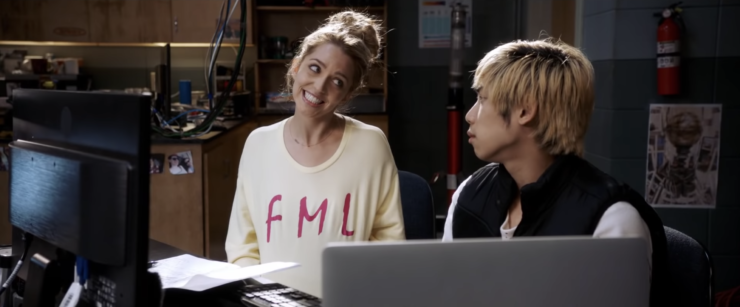
Tree’s extended death montage is where Happy Death Day 2U starts to fall apart: Tree, who in the first movie’s montage kept running into the killer or stumbling into the path of a truck while pursuing suspects, actively seeks out increasingly gruesome deaths. She chugs Drano at the store in front of a poor old man; she dives headfirst into a chipper in front of some gardeners just trying to do their job; she blithely skydives in a bikini and nothing else, only to land in front of Carter and Danielle making out and shower them in her pulverized flesh. Knowing that in each case she is etching unspeakable trauma onto the minds of every person, from unwitting strangers to the guy she supposedly loves, makes her actions seem wildly out-of-character.
But it’s also her own version of Phil Connors’ suicide montage. It’s a woman approaching death the way a man does. In the last scenario specifically, it’s a petty-but-kinda-justified revenge on Carter—who believes her after a couple loops’ worth of convincing, sure, but who also makes fun of her for not knowing the plots of either Groundhog Day or Back to the Future II. A guy who, at the end of Happy Death Day, tricks her on September 19 into thinking that she’s woken up in the time loop again, just to pull one over on her. It’s a weirdly subversive moment from a young woman who is starting to crack.
It’s too bad that Tree probably never saw Memento, either, or she could have considered tattooing all of those equations on herself instead of memorizing them—seeing as her body carries the consequences of every death, from waking up with comically floofy hair when she gets electrocuted to sustaining enough internal trauma that she should keel over if somebody looks at her the wrong way. Phil Connors can eat to excess and blow himself and poor Punxsutawney Phil to high heaven then wake up without a scratch, but a woman half his age takes on every blow, every stab, every volt of electricity.
By contrast, Nadia appears to be in the Phil camp, in which she can remember pricking her finger on one loop but won’t bear a mark on the next. (Which comes in handy when her final confrontation with her younger self results in Nadia coughing up a glass shard from her mother’s broken mirrors and dying from the internal damage.) However, the same cannot be said for the rest of her world; as Nadia and Alan retrace their steps or pursue new solutions, fruits around them turn moldy, and first mirrors and then actual people begin disappearing from Nadia’s party. Their particular universe cannot hold up to the endless rebooting, and begins succumbing to decay. At some point soon, they will run out of time.
Similarly, Tree—who spent the entire first movie living out so many slasher-style deaths that it transformed her into the quintessential Final Girl—begins to, ironically, confront her own mortality once they figure out the single algorithm that will allow the reactor to close the loop. Not knowing how many more deaths her body can take, and no longer obligated to unmask the killer to save herself, she decides to stay in the alternate reality in which she can have a relationship with her mother—even if doing so means the killer continues on his rampage. Happy Death Day 2U comes to a head when Carter confronts Tree about letting the killer’s bloodbath play out instead of interfering, begging her to think of the innocent lives to be lost.
“People die every day, Carter,” she snaps. “I can’t be responsible for all of them.”
Buy the Book
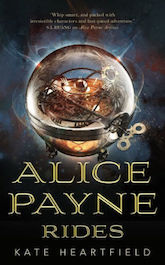

Alice Payne Rides
But she has to be.
Neither Tree nor Nadia’s time loop is solely about fixing herself; dismantling and making peace with their respective traumas is only the first step, the quintessential “put on your own oxygen mask before helping others with theirs.” Except that instead of a plane going down, it’s an innocent nurse getting a knife to the back, or a former love disappearing into the ether as if he never existed, leaving behind a confused daughter. Even if Alan’s suicide was the catalyst for Nadia’s first death and their subsequent loops, the key to living past these loops is finding each other in separate timelines and extending the helping hand they failed to on that first night. Even if Tree is able to avoid Babyface’s knife, this infinite Final Girl is called to apply all of her knowledge and training to helping the killer’s would-be victims who cannot help themselves. Because the alternative is a timeline collapsing, or the world rotting from the inside out.
Phil Connors may joke about becoming a god, but this cynical woman and this selfish co-ed are forced to ascend to a near-impossible level of sainthood. While Phil must accept that death—in the form of the old homeless man Pops, who he can never save—is the one thing that he cannot change, Nadia and Tree are granted the rare power to cheat death, to reverse it, and to stave it off that much longer. In dying over and over again, they must embody the selflessness, the generosity, the courage, the care that is already expected of women, from every tiny act of emotional labor to every colossal sacrifice.
Natalie Zutter is still seething over Tree getting dragged for her lack of movie knowledge. If Happy Death Day 3 really does happen, she’d love to see someone give Tree a break. Talk time loops with her on Twitter!











I think I’ll hold off on reading the article for a moment due to spoilers, but I do have a question regarding Russian Doll. I keep seeing reviews talking about how good it is, but episode one really fell short for me. I didn’t like the characters at all and wasn’t even enjoying the time loop plot yet. About how long does it take to get good? My level of disdain for the people in the story was pretty high and if it’s more than three episodes or so I don’t think I’ll be able to stomach finishing it. I need either a plot bigger than “my cat is missing and also random death” or some real character development from the protagonist to start caring.
@1 The end of the third episode is when the plot really thickens. The fourth is a complete narrative shift.
I enjoyed Russian Doll and both of the Happy Death Day movies immensely, with Russian Doll being the easy favorite.
I’m not sure I share your interpretation of the multiverse theory in Happy Death Day 2U. I may have missed it, but it didn’t seem to me that they were implying that every one of her deaths spun off a parallel universe, just that the accident pushed her into a parallel universe.
I did have a different problem with her little death spree. Why the heck was she killing herself in such extreme, damaging, ways (other than the humor value)? She was a smart woman. She knew that these were taking a lasting toll on her. Why not just take a sedative and lock herself in a cooler to die of hypothermia? Or just an overdose of the sedative? Or any number of other less traumatic deaths. That annoyed me.
I also was a bit unhappy with the ethical implications of the mid-credits stinger.
But overall, I enjoyed it almost as much as the original.
I haven’t seen either of the new ones, though I have seen Groundhog Day numerous times and own Back to the Future. I am also a fan of time loop stories and would like to recommend two that (unfortunately for this article) don’t center on females.
The first is a fascinating little gem called Primer. It was written by university student physist and has real-world science, though obviously not enough to build a real time machine. I can’t say enough about how creepy the ending is. This rewards multiple rewatches, and also overthinking the results (if you call the mindworms it creates a reward. I can get squicked out just thinking of it and I haven’t seen it for a year.) I really should buy the download; it’s no longer available for purchase but you can get digital copies for twenty bucks from the director’s site.
The second is a TV show called Daylight [2006 season.] I usually explain it as Groundhog Day: The Cop Show. An officer wakes up one morning, goes through the day, bad stuff happens, people die. Wakes up the next morning to the same song. The interesting twist is that as he tries to fix things he starts making subtle changes — fixing the problem the right way allows those people to realize something is wrong earlier in the day. They are no longer something he has to relive, and can focus on other things. Sadly, it only lasted one season, but that season is a self-contained mystery and only offers a wink that season two will appear and deepen the story. Definitely worth a peek for time-loop enthusiasts.
#4: “The second is a TV show called Daylight [2006 season.]”
Actually Day Break, not Daylight. Quite a good show.